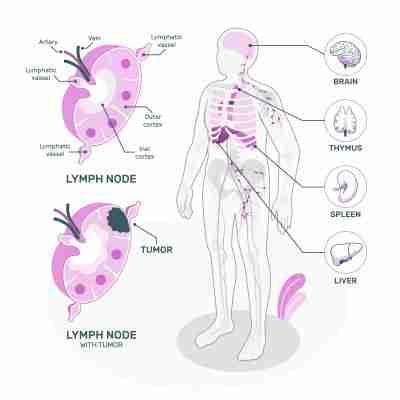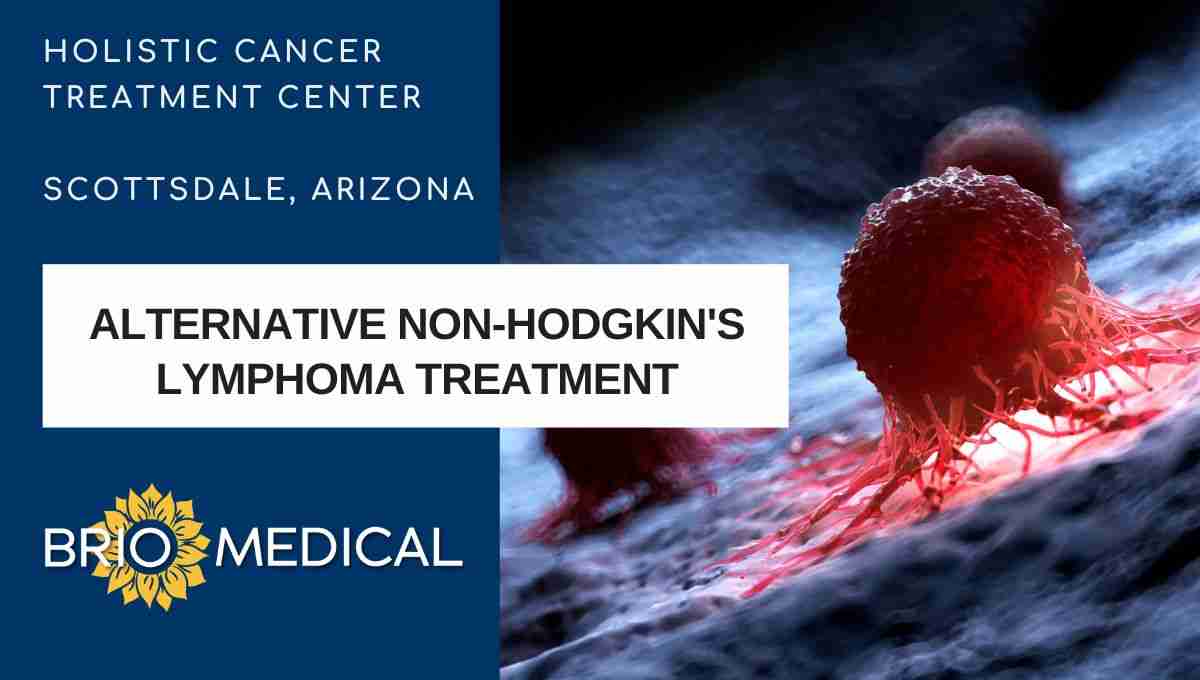Non-Hodgkin Lymphoma Treatment Program
Lymphoma is a general term referring to cancers of the lymphatic system, a complex network of lymphoid organs, tissues, and cells that help the body eliminate unwanted materials and waste. The lymphatic system mainly consists of the bone marrow, thymus, lymphocytes, lymph fluid, vessels, and lymph nodes. Among other functions, this system is crucial for maintaining the body's immunity.
Non-Hodgkin's lymphoma (NHL), or non-Hodgkin lymphoma, is a cancer that starts in the lymphocytes (white blood cells), specifically B-cells and T-cells. New cases of non-Hodgkin lymphoma occur at an annual rate of 19 per 100,000 people. The annual death rate is about 5% in 100,000 adults. Most cases of non-Hodgkin lymphoma are considered highly treatable, and the 5-year survival rate of NHL patients is pretty good at over 70%.
How Does Non-Hodgkin's Lymphoma Occur?
Non-Hodgkin's lymphoma affects either B-cell or T-cells, two common types of lymphocytes. B-cells and T-cells mainly live in the hundreds of lymph nodes distributed throughout the body. They travel through the blood and lymph vessels when signaled to do so.
B-cell development starts in the bone marrow, where precursor B-cells mature and eventually settle in the various lymph nodes. Once activated, B-cells differentiate into plasma cells, which release antibodies or centroblasts that proliferate and mature into plasma cells or memory B-cells.
Conversely, T-cells develop in the thymus from processor embryo cells produced by the bone marrow. They eventually differentiate into helper T-cells or cytotoxic T-cells, which again settle in the lymph nodes.
The development of T-cells and B-cells involves several sequences of cell division and differentiation. A gene mutation can occur during one of these sequences, causing the affected cell to proliferate out of control and become resistant to apoptosis (programmed cell death). Such cells become neoplastic and will often clump together to form cancerous tumors.
These tumors normally start in the lymph nodes (nodal lymphoma), but they can develop outside the lymph nodes, too (extranodal lymphoma). Some NHL tumors can also travel to various parts of the body, such as the liver, bone marrow, spinal cord, gut, and skin.
Non-Hodgkin's Lymphoma vs. Hodgkin's Lymphoma: What’s the Difference?
The only distinction between Hodgkin's and non-Hodgkin's lymphomas is the presence or absence of a particular cell called the Reed-Sternberg cell. If this cell is present, the lymphoma is classified as Hodgkin's; otherwise, it is classified as non-Hodgkin's lymphoma.
What Are the Different Types of Non-Hodgkin's Lymphoma?
NHL is categorized into two main groups: non-Hodgkin B-cell lymphoma and non-Hodgkin T-cell lymphoma.
Non-Hodgkin B-Cell Lymphoma
Non-Hodgkin B-cell lymphoma is the more common of the two NHL groups. It’s further subdivided into indolent, aggressive, and highly aggressive types. Common types of non-Hodgkin B-cell lymphoma include:
- Diffuse Large B-cell Lymphoma (DLBCL) – The most common NHL, accounting for about 31% of all adult cases in the U.S. It’s an aggressive lymphoma that’s often extranodal.
- Follicular Lymphoma (FL) – The most common type of indolent NHL.
- Mantle Cell Lymphoma (MCL) – An aggressive lymphoma that starts in the outer edge of a lymph node follicle known as the mantle zone.
- Burkitt Lymphoma (BL) – A highly aggressive NHL. It often causes extranodal involvement of the jaw and abdomen.
- Lymphoplasmacytic Lymphoma – An indolent lymphoma that commonly affects the lymph nodes, bone marrow, and spleen. It’s also known to cause Waldenström macroglobulinemia, a rare condition where the blood thickens due to high levels of M-proteins dumped by neoplastic B-cells.
- Marginal Zone Lymphoma (MZL) – An indolent NHL that can be nodal or extranodal. It affects the spleen and the mucosa-associated lymphoid tissues (MALT).
Non-Hodgkin T-Cell Lymphoma
Common subtypes of T-cell NHL are:
- Adult T-cell Lymphoma (ATL) – Is thought to be caused by the Human T-Lymphotropic HTLV-1 virus. It’s sometimes considered a leukemia because cancerous leukocytes often enter the bloodstream.
- Mitosis Fungoides – This may cause Sezary syndrome, where the skin develops lesions similar to a fungal infection.
- Other rare forms of non-Hodgkin T-cell lymphomas include Angioimmunoblastic T-Cell Lymphoma, Systemic Anaplastic Large-cell Lymphoma, and Peripheral T-cell Lymphoma.
What Causes Non-Hodgkin’s Lymphoma?
We still don't know exactly what causes non-Hodgkin lymphoma. But lab tests, clinical trials, and research into the history of NHL patients have revealed several risk factors associated with the incidence and mortality of non-Hodgkin lymphoma. These risk factors include:
- Suppressed immune system – A weakened immune system due to infection, medication, or immune-related disorders can increase your chances of developing lymphomas.
- Viral and bacterial infections – Certain viral infections such as Epstein-Barr virus (EBV) and Human T-Lymphotropic HTLV-1 virus and bacteria such as Helicobacter pylori are closely linked to NHL occurrence.
- Exposure to certain toxins and chemicals – High doses of chemicals such as Agent Orange, benzene, and petrochemicals can elevate the risk of developing certain types of NHL.
- Exposure to ionizing radiation – Like most cancers, prolonged or high-dose exposure to ionizing radiation (X-rays, Gamma-rays, UV, etc.) can cause NHL-triggering genetic mutations.
- Age – NHL mostly affects older people (over 60 years).
- Gender – Certain types of NHL are slightly more prevalent in men, while others seem more common in women. This correlation is not well understood.

What Are the Signs and Symptoms of Non-Hodgkin's Lymphoma?
The signs and symptoms of non-Hodgkin lymphoma vary from patient to patient and depend on the type of NHL and its progression. While some cases are asymptomatic, most NHL patients present with one or more of the following symptoms:
- Enlarged lymph nodes (painless lymphadenopathy)
- Night sweats
- Pain or pressure on the chest
- Persistent fever
- Weight loss greater than 10% of BMI
- Bowel obstruction if there’s extranodal involvement of the gut
- Anemic symptoms (easy bruising, fatigue, recurring infections, etc.) if there's extranodal involvement of the bone marrow
- Weakness and loss of sensation, especially in the leg, if the cancer cells reach the spinal cord
Diagnosing and Staging Non-Hodgkin's Lymphoma
Non-Hodgkin’s lymphoma is one of the more difficult cancers to diagnose accurately. A clinical NHL diagnosis involves a lymph node biopsy, which can take days or weeks to confirm. Once the disease has been positively identified, an imaging test is done to measure its extent or stage of development. The imaging test can be a PET or a CT scan; if that's not enough, a bone marrow biopsy may be required. Staging is necessary for informing the suitable treatment regimen and predicting prognosis.
Non-Hodgkin’s lymphoma has four stages:
- Stage 1 – Cancer cells are only present in one lymph node area.
- Stage 2 – Cancer cells are in two or more lymph node areas but on the same side of the diaphragm.
- Stage 3 – Cancer cells are present in multiple lymph node areas above and below the diaphragm.
- Stage 4 – Cancer cells have spread beyond the lymphatic system.
How We Treat Non-Hodgkin’s Lymphoma
Conventionally, non-Hodgkin's lymphoma is treated through chemotherapy, radiation therapy, or a combination of the two. The dosage and agents used in these treatments depend on the type, aggressiveness, and stage of the disease. But the more intense or prolonged the treatment, the heavier the toll on the patient's body. And that's the biggest problem with traditional NHL treatments.
But there are other less invasive and safer ways to treat non-Hodgkin’s lymphoma. And these are centered around holistic therapies.
What is holistic cancer treatment? You can also call it natural or alternative cancer medicine. It’s a treatment methodology that stimulates the body's innate healing abilities to fight infections, cancer, and other chronic diseases. The upside is that there are barely any side effects to worry about, and the wholesome healing starts in the body as well as the mind and spirit. In fact, many of our treatments can be used alongside other medications to ease side effects and improve the patient’s response and well-being.
We have a wide variety of treatment options that target healing from within rather than address the superficial symptoms alone. Your choices of Brio-Medical holistic cancer treatments include:
- Vitamin C IV therapy for low-dose chemo
- Photo Biomodulation Therapy (Halo)
- Hyperthermia
- Immunotherapy
- Alpha Lipoic Acid (ALA) IV Therapy
- Pulsed Electromagnetic Field (PEMF) Therapy
- Ozone Therapy
- Low-Dose Metronomic Chemotherapy
Get in touch with us and start your healing journey the natural way.
References:
- National Cancer Institute. “Cancer Stat Facts: Non-Hodgkin Lymphoma.” The Surveillance, Epidemiology, and End Results (SEER) Program. Cancer Statistics. Accessed September 9, 2022.
- American Cancer Society. Cancer.org “Treating T-Cell Non-Hodgkin Lymphoma” Cancer A-Z. Last Revised: August 3, 2021. Accessed September 9, 2022.
- Thandra, Krishna C et al. “Epidemiology of Non-Hodgkin's Lymphoma." Medical sciences (Basel, Switzerland) vol. 9,1 5. January 30, 2021, doi:10.3390/medsci9010005.
- MedlinePlus. National Library of Medicine. “Waldenström macroglobulinemia.” Last updated September 24, 2021. Accessed September 9, 2022.
- Gessain, Antoine, and Olivier Cassar. “Epidemiological Aspects and World Distribution of HTLV-1 Infection.” Frontiers in microbiology vol. 3 388. 15 Nov. 2012, doi:10.3389/fmicb.2012.00388.
- MedlinePlus. National Library of Medicine. “Sézary syndrome.” Last updated May 17, 2021. Accessed September 9, 2022.
- National Library of Medicine. StatPerarls [Internet]. Aggarwal P, Limaiem F. “Reed Sternberg Cells.” Updated July 26, 2021. Accessed September 9, 2022.
- The American Cancer Society medical and editorial content team. “Non-Hodgkin Lymphoma Risk Factors” Last Revised: June 9, 2020. Accessed: September 10, 2022.
- The American Cancer Society medical and editorial content team. “Signs and Symptoms of Non-Hodgkin Lymphoma” Last Revised: August 1, 2018. Accessed: September 10, 2022.



